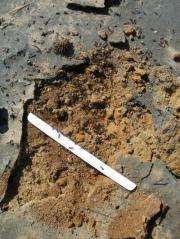Aznalcollar disaster compared with Cretaceous mass extinction

Researchers from the University of Granada (UGR) have compared the disaster caused by the Aznalcóllar spillage in the Doñana National Park in Andalusia 11 years ago with the biggest species extinction known to date. What do these two disasters have in common? The scientists say that carrying out comparisons of this kind will make it possible to find out how ecosystems recover following mass extinctions.
Until now, scientists used to study the fossil record in order to analyse how organisms responded to major environmental changes in the past, such as the mass extinction of species during the Cretaceous period (65 million years ago) and their subsequent recovery.
Now a team of scientists from the UGR has proposed a different methodology: "Another way of looking at this issue is to compare present day disasters that have also caused an abrupt ecological change, and which have therefore also had a major impact on organisms", Francisco Javier Rodríguez-Tovar, lead author of the study and a researcher at the UGR's Department of Stratigraphy and Palaeontology, tells SINC.
The study, published recently in the journal Geobiology, was based on "one of the worst environmental disasters to have happened in Spain over recent decades".
The pyrite mine at Aznalcóllar, in the Doñana National Park, burst on 25 April 1988, spilling four million cubic metres of acidic water and one million cubic metres of waste material containing high levels of toxic compounds, which affected more than 4,500 hectares of the rivers Agrio and Guadiamar and the land around them.
The researchers carried out a detailed analysis of how the pollution from Aznalcóllar evolved, and how the local plant and animal communities responded following the event, by studying the affected soil. "Comparing this with what happened 65 million years ago could help to better interpret this past event", explains Rodríguez-Tovar.
The similarities are obvious - sudden impact, high levels of toxic compounds, and the existence of a polluted layer covering the affected area. However, the scientist also points out some of the most significant differences, such as recovery following the impact, which was "much faster after the disaster at Aznalcóllar", and in terms of the area affected, which was "global for the Cretaceous-Tertiary boundary event", says Rodríguez-Tovar.
In search of signs of life
The scientists were able to carry out a range of experiments on the layers of mud that have not been removed from Doñana. Geochemical analysis showed that "there is still significant contamination, with high concentrations of toxic elements, and high acidity levels", stresses the palaeontologist. However, less than 10 years after the disaster, the scientists could identify trails and nests made by Tapinoma nigérrima, an aggressive and opportunistic species of ant. "We even found this ant's larvae just below the layer of highly-contaminated mud", explains the expert.
This ant's opportunism, aggressiveness and high levels of independence were compared with the organism that created Chondrites, a trace fossil that scientists have recorded near the red layer associated with the Chixulub crater in Mexico, generated by the impact of the meteorite that caused the Cretaceous-Tertiary extinction. Previous ichnological studies (on trace fossils) have shown that "the Chondrites-generating organism was able to inhabit the substrate immediately after the event, due to its opportunistic and independent nature", says Rodríguez-Tovar.
Using the data on trace fossils and on comparisons with present day disasters, the scientists were able to prove that "the community started to recover fairly rapidly following the mass extinction caused by the impact 65 million years ago, possibly within hundreds or thousands of years", concludes the palaeontologist.
More information: Rodríguez-Tovar, F.J.; Martín-Peinado, F.J. "The environmental disaster of Aznalcollar (southern Spain) as an approach to the Cretaceous-Palaeogene mass extinction event" Geobiology 7(5): 533-543 Dec 2009.
Provided by FECYT - Spanish Foundation for Science and Technology

















